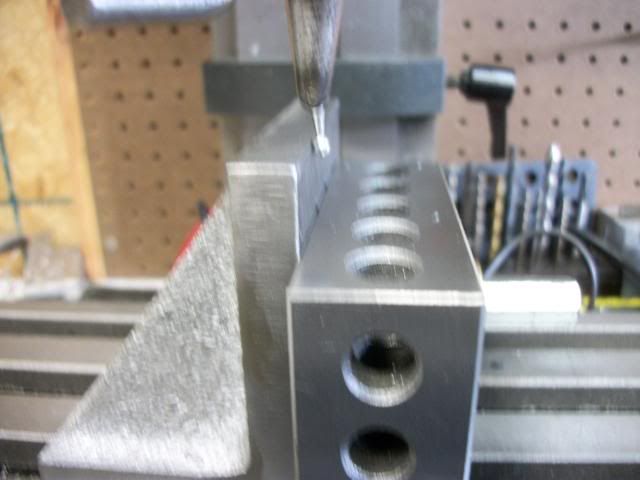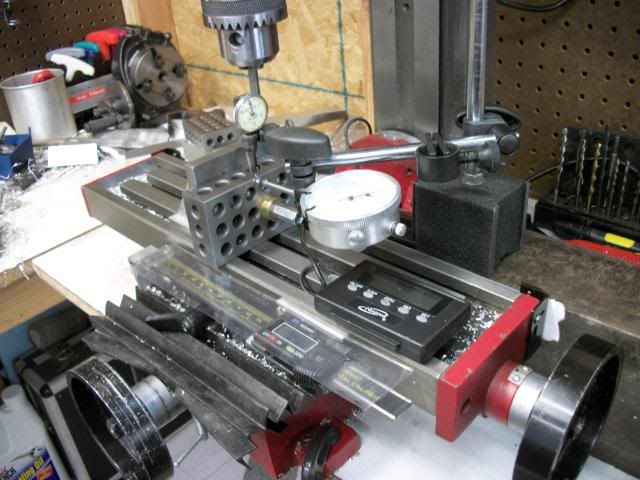- Joined
- Dec 2, 2008
- Messages
- 971
- Reaction score
- 8
My head hurts.
I spent the morning installing a 12" digital remote scale on my HF X2 mill. I spent the afternoon pulling my hair out. The scale is the $35 from Grizzly(Igaging). The installation was fairly simple. I know I got the mounting method from a HMEM post but I cant find it for the life of me. The scale is mounted across the rear of the table where it is out of the way of gib screws and locks and robs only about ½ of Y travel. When finalized it will be fully protected by a U shaped channel bent up from roof flashing material. Only the bottom of the channel will be open so swarf should not be a problem and I dont use a lot of lubricant.
This was installed to replace a quickie/cheapie digital caliper set up that I was pretty happy with until discovered how inaccurate it was. It cost me a couple of screwed up parts before I figured out the error was in the caliper scale.
Once I got the new scale installed and working, I decided to test it using the same method that had showed up the inaccuracy of the caliper. I used an edge finder to locate the opposite faces of a 1-2-3 block. I have been told that the only really accurate way meaure is with a really good micrometer but even a cheap micrometer is better than a digital caliper. I havent figured out a way to install a micrometer on the mill table but my cheap micrometer says that my 1-2-3 block is indeed 1 inch thick so that will be the standard that I will measure. By locating one edge, zeroing the scale and locating the opposite edge, I should get a scale reading of 1.200 (The edge finder has a .200 dia tip) but the results I was getting varied from 1.196 to 2.218. WTF! Following good advice from HMEM members, I cleaned and oiled the edge finder. I got better results, but I also got stiff neck from trying to see the edge finder from both sides. I couldnt use the feed screw dials as a check because of backlash since I had to approach the edges from opposite directions.
More thinking, AHA!
I bolted the 1-2-3 block to an angle block so that the upper edge of the angle block sits about 3/8 higher than the 1-2-3 block. Now I could locate the edge of the 1-2-3 block, zero the scale AND the dial, raise the head and locate the face of the angle block. The scale should read 1.000 and the dial should read zero. The results were better but still not totally consistent. It must be the edge finder.
More thinking. AHA!
Replace the edge finder with a DTI. Much more reliable and more readable. Thats what I did and I finally thought to take some pictures. Here is a pic of the setup.

Now I get very repeatable results. The DTI and the dials agree and the scale display reads 998. This is 6 times greater than the advertised error of less than .001 in 3. While scratching my ###d I noticed the display start to jump around ending up at 1.598 Maybe weak batteries? Maybe bad installation.
Has anyone tested the accuracy of these scales with better results? Has anybody had whacky numbers jump up? Tomorrow, I will install fresh batteries and double check the installation but for now I rigged up a 1 dial indicator and re-installed the caliper set-up. (it doesnt interfere with the scale). I ran a few tests and I am getting 1.000 from the dials, from the DTI, and the dial indicator. The Igaging scale reads .998 and the calipers read 1.002. If I reverse the travel, all return to ZERO reliably. My head hurts.
Here is a pic of the full test setup

Jerry
I spent the morning installing a 12" digital remote scale on my HF X2 mill. I spent the afternoon pulling my hair out. The scale is the $35 from Grizzly(Igaging). The installation was fairly simple. I know I got the mounting method from a HMEM post but I cant find it for the life of me. The scale is mounted across the rear of the table where it is out of the way of gib screws and locks and robs only about ½ of Y travel. When finalized it will be fully protected by a U shaped channel bent up from roof flashing material. Only the bottom of the channel will be open so swarf should not be a problem and I dont use a lot of lubricant.
This was installed to replace a quickie/cheapie digital caliper set up that I was pretty happy with until discovered how inaccurate it was. It cost me a couple of screwed up parts before I figured out the error was in the caliper scale.
Once I got the new scale installed and working, I decided to test it using the same method that had showed up the inaccuracy of the caliper. I used an edge finder to locate the opposite faces of a 1-2-3 block. I have been told that the only really accurate way meaure is with a really good micrometer but even a cheap micrometer is better than a digital caliper. I havent figured out a way to install a micrometer on the mill table but my cheap micrometer says that my 1-2-3 block is indeed 1 inch thick so that will be the standard that I will measure. By locating one edge, zeroing the scale and locating the opposite edge, I should get a scale reading of 1.200 (The edge finder has a .200 dia tip) but the results I was getting varied from 1.196 to 2.218. WTF! Following good advice from HMEM members, I cleaned and oiled the edge finder. I got better results, but I also got stiff neck from trying to see the edge finder from both sides. I couldnt use the feed screw dials as a check because of backlash since I had to approach the edges from opposite directions.
More thinking, AHA!
I bolted the 1-2-3 block to an angle block so that the upper edge of the angle block sits about 3/8 higher than the 1-2-3 block. Now I could locate the edge of the 1-2-3 block, zero the scale AND the dial, raise the head and locate the face of the angle block. The scale should read 1.000 and the dial should read zero. The results were better but still not totally consistent. It must be the edge finder.
More thinking. AHA!
Replace the edge finder with a DTI. Much more reliable and more readable. Thats what I did and I finally thought to take some pictures. Here is a pic of the setup.

Now I get very repeatable results. The DTI and the dials agree and the scale display reads 998. This is 6 times greater than the advertised error of less than .001 in 3. While scratching my ###d I noticed the display start to jump around ending up at 1.598 Maybe weak batteries? Maybe bad installation.
Has anyone tested the accuracy of these scales with better results? Has anybody had whacky numbers jump up? Tomorrow, I will install fresh batteries and double check the installation but for now I rigged up a 1 dial indicator and re-installed the caliper set-up. (it doesnt interfere with the scale). I ran a few tests and I am getting 1.000 from the dials, from the DTI, and the dial indicator. The Igaging scale reads .998 and the calipers read 1.002. If I reverse the travel, all return to ZERO reliably. My head hurts.
Here is a pic of the full test setup

Jerry




